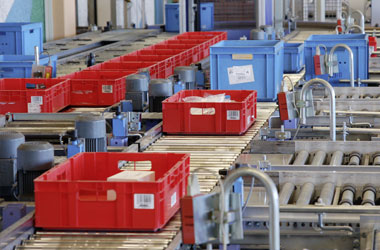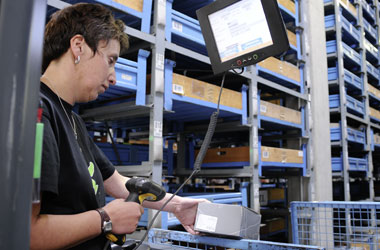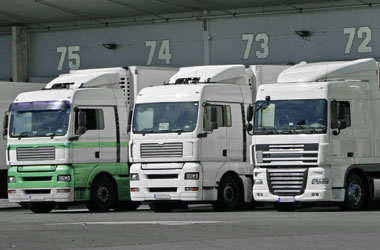SAP LES (SAP Logistics Execution System) – ERP-integrated warehouse control
SAP LES (SAP Logistics Execution Systems) has proven its worth over many years as an integrated component of SAP R/3 and the SAP product suite SAP ERP (SAP Enterprise-Resource-Planning) (ECC).
With over 5,000 production system installations, SAP LES (SAP Logistics Execution System) is the most commonly-used software suite for warehouse management and control worldwide.
The principal components within SAP LES (SAP Logistics Execution System) are the warehouse management module SAP WM (SAP Warehouse Management) and the material flow module SAP TRM (SAP Task and Resource Management).
The deployment of SAP LES (SAP Logistics Execution System) means external warehouse control systems (WMS/MFS) for automated and manual warehouses are no longer needed. Interfaces, dependencies and costs are significantly reduced.
Functional overview of SAP LES (SAP Logistics Execution System)

With SAP Handling Unit Management (SAP HUM), SAP offers comprehensive functionality for the mapping of multi-stage package structures and the filing of packing instructions. Standards such as shipment IDs (SSCC) and GR/GI notifications at the package level can be used end-to-end across the entire supply chain, as well as for intercompany movements.
Traceability pursuant to EU Regulation 178/2002 and serial number handling receive optimal support from SAP HUM.

Since its R/3 Rel. 4.7 (Enterprise), SAP has supplied the SAP LES-integrated (SAP Logistics Execution System) material flow control component SAP TRM as part of standard SAP. SAP Task and Resource Management (SAP TRM) is an add-on to SAP Warehouse Management (SAP WM) and enables the detailed mapping and optimisation of multi-stage material flows within the warehouse. SAP TRM (SAP Task and Resource Management) can, as a SAP MFC (SAP Material Flow Controller), communicate directly with the underlying programmable logic controllers (PLCs) of an HBS or AS/RS system, such as SIEMENS S5/S7. This effectively makes the deployment of external material flow control systems surplus to requirements – reducing the number of interfaces and simplifying communications.

SAP ITSmobile communicates directly with browser-based MDC equipment and provides a set of purpose-built front ends. The browser is located on the user device, which uses HTML/Business HTML to communicate directly with the SAP web application server. SAP ITSmobile requires no proprietary clients as standard, and offers unlimited use of operator accounts from within the SAP system. With the SAP standard RF transactions, SAP ITSmobile offers a wide range of configuration options and supports a huge variety of user devices. This gives system owners a lot of flexibility when choosing their implementation/hardware partner. Supplementing SAP ITSmobile, SAPConsole offers a proven and solidly field-tested SAP RF communication solution based on ASCII/Telnet.

The SAP Express Ship Interface (SAP XSI) is the SAP LES (SAP Logistics Execution System) standard component for the filing of all relevant routing information from transportation service providers in SAP. This can be used to print the necessary shipping documents (package/pallet labels, goods arrival manifests, etc.) directly from within SAP and send the EDI payment advice notes. Shipping subsystems and specific software/printers from transportation service providers are no longer required with SAP XSI. Comprehensive, integrated Track & Trace functions for the general cargo and parcel service providers connected to SAP support Sales and Customer Service teams when handling customer queries.

SAP TRM (SAP Task and Resource Management) stores all of the physical coordinates (X, Y, Z), travel distances/routes and properties of the stackers in the warehouse. This makes the optimum assignment of convey instructions to stackers possible in real time. Travel is minimised, task interleaving is generated and deadheading is avoided. Comprehensive TRM (SAP Task and Resource Management) functions for monitoring and priority control for pending shipments provide the control station with all of the required information and opportunities for effective control. The recording of dwell time at delivery points and buffer storage areas enables the real-world determination and evaluation of transportation times.

SAP Yard Management offers an effective approach to the management of all incoming and outgoing trucks, trains, swap bodies and containers. This enables material flows to be coordinated even beyond the "four walls" of the warehouse by managing the yard and gates. A comprehensive set of functions, such as an electronic planning board with the assignment of timeframes to forwarding agents, etc. is available.

Value-added services are additional services in logistics, such as assembly, labelling, packing and kitting, and can be executed in the warehouse via corresponding orders. A number of additional services that are performed in the warehouse can be recorded in terms of their value. The recording method necessary and the on-debiting of these services to the customer can thereby be almost entirely automated.


![[Translate to English:] SAP LES (Logistics Execution System) | IGZ [Translate to English:] SAP LES (Logistics Execution System) | IGZ](/fileadmin/user_upload/Automation/SAP_Module/SAP_LES/igz-sap-les-logistics-execution-system.jpg)